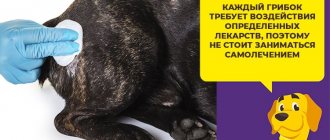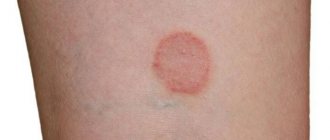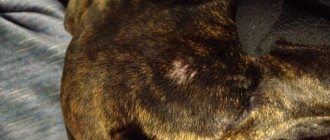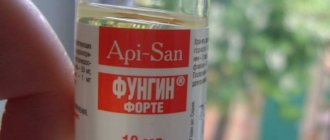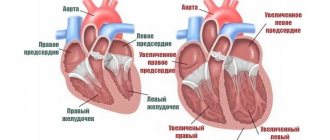A viral or fungal skin disease is called lichen. Pathology occurs in animals, most often in cats and dogs.
Ringworm occurs not only in homeless animals. It is also found in pets whose owners let them go outside for walks. Ringworm in animals is transmitted to them from others, through direct contact, by ticks, lice and other parasites. If signs of lichen are detected, the animal must be treated. This disease does not go away on its own. The owner of a dog or cat should be careful, as some types of lichen in animals can be transmitted to humans.
What does lichen look like in animals?
In domestic dogs, lichen usually appears on the pet's face, belly, and paws. First, single lesions appear, then the infection spreads throughout the skin. The first changes affect the condition of the coat. Hair becomes brittle and falls out. Bald areas are characterized by a rounded shape with fairly clear boundaries.
Over time, the skin begins to peel off, change color, and inflammatory processes are possible. The pet becomes lethargic and passive. Sometimes the temperature may rise.
The concept of lichen and the causes of its occurrence in humans
Ringworm is a skin lesion that causes inflammation, peeling, itching and redness. It can also be caused by the appearance of a rash, changes in skin color and hair loss. Skin lesions may appear due to fungus or viruses that infect the skin.
There are different types of lichen; psoriasis and eczema also stand out among others. These types have a separate classification. It is imperative to know which types of lichen are contagious.
The reasons for the appearance of lichen in humans can be varied: increased stress, immunodeficiency, taking antibiotics, metabolic disorders, high susceptibility to allergens. More than half of cases of lichen in humans are hereditary.
Infection with lichen can occur through contact with animals, since most types of this disease are the same in humans and animals. It is also quite easy to become infected through contact with the ground if you do not use gloves.
In this regard, the question arises what types of lichen exist.
Symptoms of ringworm in pets
First, your pet develops a rash. Then the hairs begin to break and the fur begins to fall out (hence the name “haircut”). Itching causes the animal:
- irritability;
- discomfort;
- anxiety;
- loss of appetite.
Lack of treatment leads to the appearance of “rings” on the skin - round spots with a red border. They may itch and peel, and after a while blisters appear. They are replaced by purulent, weeping wounds. If the disease continues to be ignored, the infection will enter the bloodstream and the fungus can affect the brain. As a result, the pet will die.
How to treat ringworm in animals
If you notice symptoms of ringworm, see your doctor immediately. Treatment is a must! The skin disease will not go away on its own, but the owner may become infected. Therefore, it is important to isolate the animal and provide it with a separate room (a spacious cage).
For the treatment of ringworm in dogs, medications are as follows:
- Vakderm is a vaccine that is used to prevent and treat fungal infections.
- Liverazol is a solution for external use, intended for the treatment of dermatophytoses.
- - a good answer to the question of how to treat lichen in a cat. The ointment kills fungus and harmful bacteria, improves skin regeneration.
- Zoomikol is an anti-lichen spray for cats and dogs that has fungicidal activity and is easy to use.
If there is a risk that the animal will lick the ointment, put a collar on it. Otherwise, in attempts to get rid of the unpleasant odor, it may become poisoned.
What to do if your pet has ringworm
Take precautions:
- During treatment, you should not bathe the animal.
- If there are other pets at home, do not allow them near the sick animal, give it a separate bowl.
- Do not pet your pet and do not allow children to have contact with it.
- Clean the apartment with disinfectants (bleach and hot water).
- Ventilate the room where the sick animal is located.
- Do not walk your dog for long periods of time so as not to infect other pets.
- To disinfect the room, turn on the quartz lamp daily. The sick animal must first be removed from the premises.
Do not kick your pet out of the house or kill it for fear of becoming infected. Consult your doctor to find out how to treat ringworm in your dog and cat. Remember: the infection can be treated!
Microsporia in cats
Microsporia in cats is of great epidemiological importance, due to the fact that cats are a source of infection and the cause of epidemics among humans (human microsporia). With microsporia, lesions in the form of flaky or crusty surfaces are located on the head, near the ears, on the inner surface of the ears, torso, and at the base of the tail. It is characteristic that microsporia causes hair fragility at approximately the same level from the skin itself, throughout the affected area. Upon visual inspection of such a lesion, the cat owner gets the impression that the fur has been cut, which is why this type of lichen received the name ringworm. Such hair can be pulled out easily and painlessly. The base of the hair is covered with a small sheath of fungal spores.
The disease in cats occurs in superficial, deep and erased forms.
The superficial form, when fully clinically manifested in a cat, is accompanied by hair loss and peeling of the skin in barely noticeable or large areas of the body. On clinical examination, such skin is swollen, with a bluish tint. In some cats, the superficial form occurs with a clearly expressed inflammatory reaction and the formation of crusts.
The deep form of microscopy is rare in cats.
Erased form - most common in cats, lasts for months (7-9 months). With this form, only individual hairs are affected on the mustache, nose, ears, eyebrows of the head, neck, base of the tail and other places.
The diagnosis of ringworm is made based on the clinical picture of the disease and the results of laboratory testing of affected areas of skin that have not been treated. In a veterinary laboratory, pathological material is examined under a microscope and then inoculated onto special nutrient media. At the veterinary clinic, specialists carry out express diagnostics using a Wood's lamp (under microscopy, we register an emerald green glow, but with trichophytosis there is no glow).
Differential diagnosis. When carrying out differential diagnosis, it is necessary to exclude demodicosis, dermatitis, pyoderma, and allergies.
Treatment. Ringworm involves isolating a sick cat in a separate room, which must be periodically ventilated and periodically wet cleaned with disinfectants.
Treatment depends on the severity of the disease, the number of affected areas and the state of the body's immune system. At the onset of the disease, veterinary specialists receive good results from the use of therapeutic and preventive vaccines. In the case when a cat has damage to large areas of the skin, antifungal drugs are used (Griseofulvit, Dermicotsid - produced in the form of solutions in ampoules of 5 ml, administered in a dose of 1-2 ml into the thigh area 2-3 times with an interval of 3-3 5 days). In case of a generalized process, these drugs are used both externally and internally.
The main signs of pityriasis versicolor in dogs and cats
The fungus affects the hair follicles, which negatively affects the animal's coat, causing seborrhea and baldness. If the infection gets on the claws, they peel off and collapse.
The spots are yellow-brown in color, the edges resemble lace. They peel off, become covered with bran, and if left untreated, merge with each other. There is not always itching. In winter, the spots may disappear.
How to treat lichen in cats and dogs
Tinea versicolor is a non-contagious disease, so the pet does not need to be isolated. Therapy is similar to the actions for the ringworm form - Vakderm, Yam, Zoomikol. Make sure that the animal does not lick the medicine for lichen, otherwise it may be poisoned.
Pay special attention to immunity - take care of good nutrition, give vitamins and minerals. In summer, walk with the animal in the morning and evening, avoid direct sunlight. If your home has air conditioning, turn it on.
Signs of infection, diagnosis
To become infected with cat lichen, you do not have to come into contact with an infected animal.
Fungi that cause the disease spread through microscopic spores through the air and can settle anywhere. Even a domestic cat is at risk of getting sick. For example, the owner can sit on a bench where an infected animal previously lay. When he returns home, the cat only needs to rub against his legs to catch the infection. Of course, such cases do not happen often, and it is not worth living in constant tension. You just need to not ignore the first warning signs - scratching, bald spots, more abundant shedding than usual.
The incubation period from the day of infection until the appearance of the first symptoms is from one week to three months. Much depends on the animal’s immunity.
Ringworm occurs in two forms:
- Microsporia. The skin of the nose, ears, head, paws, and less commonly other parts of the body are affected. If the lichen is located on the paws, then the claws become deformed. The fur breaks off at skin level, individual hairs are easily pulled out or fall out. This contributes to the spread of the disease - fungal spores attached to the base of the hair immediately spread through the air.
- Trichophytosis is much less common. In this form, only the cat's head and neck become bald.
Signs of ringworm in cats are the same for both forms of the disease:
- Small bald patches appear. They are almost invisible; it may seem that a small piece of fur was lost when the cat got caught on something or had a fight with other cats. At this stage, the cat behaves calmly and has a normal appetite.
- Bald patches are increasing. They do not have clear outlines; individual spots, spreading across the skin, unite into one large spot of uncertain shape. This spot also continues to spread, affecting larger and larger areas. Baldness is noticeable; whitish scales appear on the areas affected by lichen; they look like an ash-white coating.
- The animal is covered with extensive spots, the hair next to the spots is broken off and looks “mowed”. Bald areas may be greyish, yellowish or reddish in color. The cat becomes restless and suffers from itching.
In more advanced cases, the cat’s well-being worsens. Appetite disappears, depressed mood and anxiety appear.
Only a veterinarian will be able to make the correct diagnosis and prescribe the treatment necessary in a particular case. A number of laboratory tests are carried out to confirm or refute the diagnosis:
- Wood's ultraviolet lamp. The area affected by the skin disease is illuminated with the rays of a lamp. In the light of this device, the fungi begin to glow green. Usually this test is sufficient, despite the fact that the error of the method is 40%, because the doctor also focuses on the clinical picture and his experience. If the owners have already used certain medications or iodine or brilliant green for treatment, the doctor should know about this, since they suppress the glow. Completely different microorganisms can also glow. If something confuses the doctor, then other tests are prescribed.
- Scraping of skin and hairs. The biomaterial is examined under a microscope and gives highly accurate results.
- Sowing. The scales collected by scraping from the affected area are placed in a dermatophyte-nutrient medium. The nutrient medium provokes the growth of only the desired type of fungus. This test is the most accurate and provides the maximum information. But it is used only when absolutely necessary, since results can be expected within 1.5–3 weeks.
Wetting form
Ringworm is a non-contagious disease better known as eczema. The mechanism of development of the disease is unclear. It is often based on allergies, hormonal imbalances, problems with the nervous system, climate, and ecology.
What does eczema look like in pets?
The disease develops according to the following pattern:
- A small hairless swelling appears on the skin, hot to the touch (either a single or multiple lesions are possible).
- Over time, it turns into a small bubble - a papule, filled with liquid.
- The vesicle gets wet all the time and secretes liquid, sometimes with pus. Due to the source of infection, the fur “sticks together” and looks unsightly.
What to do if your cat or dog has eczema?
If you notice symptoms of eczema in cats and dogs, take zinc ointment for treatment. This is an effective drug for eczema in dogs, which dries wounds, disinfects, and accelerates skin regeneration. You can also use Yam ointment.
Similar diseases
Ringworm is often confused with other diseases. Especially with weeping, pink and multi-colored lichen. It wouldn’t hurt to look at what lichen in cats looks like in the photo and read the description of the disease.
Weeping eczema
Ringworm is not actually ringworm. That is, it is not provoked by any fungal organisms, it is not transmitted to humans.
The cause of the disease may be:
- problems with immunity;
- fleas, ticks, helminths that attacked the cat;
- allergies to food, to hair care substances;
- failure in the hormonal system;
- severe nervous shock.
Weeping eczema begins with red spots appearing on the cat's body, noticeably hotter than healthy skin. The spots become covered with blisters containing mucous fluid. When they burst, eczema becomes noticeable even on long hair. The affected area hurts so much that the cat does not allow the sore to be touched. For treatment, sulfur, salicylic, tar ointments, and a vitamin complex are prescribed.
Gibert's disease
Ringworm rosea (another name is Zhiber's lichen) is especially often mistaken for ringworm.
The main external difference is that pityriasis rosea consists of separate pink spots that do not merge with each other, which eventually become covered with a dry crust. They are clearly defined, round or oval in shape.
The ringworm does not have clear outlines, and the affected areas merge with each other.
Multicolored disease
The infectious fungus Pityrosporum is the cause of pityriasis versicolor (pityriasis versicolor). This fungus is present on the skin of both animals and humans. When favorable circumstances occur (decreased immunity), it awakens. Tinea versicolor is of fungal origin and is contagious to humans. A person with poor health can get sick quickly; in people with strong immunity, the disease may not manifest itself for years.
Characteristic symptoms for lichen:
- the appearance of oval elongated lesions on the body, the spots can be either single or merging;
- color varies from pinkish yellow to brown;
- severe inflammation is observed, as well as baldness of areas with lichen.
The treatment is long-term. The drug Imaverol is usually prescribed, the solution of which is used to treat the areas affected by lichen.
Feline dermatophytosis
Ringworm (feline ringworm, dermatophytosis) is a fungal disease. Known as microsporia and trichophytosis, because the parasitic fungal pathogens belong to the genus Microsporum canis, Microsporum gypseum and the genus Trichophyton. Microorganisms that get on the skin take root in its upper layers and feed on the epithelium.
Fungal spores may not manifest themselves for months; the impetus for their development will be:
- Decreased immunity. Cats have an innate immunity against microsporia; sometimes they can be carriers, but they themselves never get sick. But if the cat receives inadequate nutrition, is infected with parasites or falls ill, then there is a high probability of developing feline lichen.
- Cat breed. Artificially bred breeds do not have immunity to lichen (for example, Scottish, Persian cats).
- Warm and humid climate. This may be due to either a move or a damp room for some reason.
- The age of the cat matters - kittens, due to their underdeveloped immune system, are more susceptible to the disease than adult cats.
The disease is contagious to both other animals and people. Children are especially vulnerable. Dermatophyte fungi reproduce by spores that remain viable for two years. You can become infected not only from a sick animal, but also from household items if they contain spores.
Pink (shingles)
Pityriasis rosea is another skin disease of unknown origin. There are suggestions that it is inherited, has an allergic basis, or is caused by an unknown virus. Most doctors believe that the pathology is harmless, but some veterinarians disagree.
How does skin disease manifest in pets?
Externally, the disease resembles an allergy - small and large pink spots appear. They are flaky in the center, smooth at the edges. The pathology itself is not dangerous, but if bacteria gets into the wound, purulent inflammation is possible.
Home remedies for treating lichen
If expensive medications are not available to the owners, then effective folk remedies can be tried to treat lichen at the initial stage. Once a day, you can treat a pink spot on the kitten’s body with a mixture of wood ash and vegetable oil. The wound is pre-lubricated with iodine solution.
Another remedy can be used to treat ringworm in animals and humans. Mix 1 tsp in a container. 5% solution of iodine, valerian and vegetable oil. The resulting mixture is applied to the affected areas of the body 3 times a day.
You can prepare a solution from alcohol and acetylsalicylic acid. Add 1 powdered tablet to a bottle with 30 ml of alcohol and shake it thoroughly. The resulting solution is carefully applied to the affected areas of the skin with a cotton swab up to 7 times a day. The scabs on the wound cannot be removed; they must fall off on their own.
Freshly squeezed celandine juice, which is rubbed into the affected areas up to 5 times a day, helps well in the fight against lichen. You can mix equal parts olive oil and lemon juice. Moisten a cotton swab with the resulting mixture and apply it to the affected area up to 4 times a day.
The recovery process will depend on the animal's immunity. If the animal develops an allergic reaction, this treatment should be discontinued. If no traditional medicine method helps and the disease progresses, you should urgently consult a veterinarian.
Prevention of lichen in pets
- Get regularly vaccinated against fungus (Vakderm).
- Keep street animals away from your pet.
- Check your pet's skin and coat regularly.
- Treat wounds and scratches with zinc ointment and other antiseptics.
- Maintain good hygiene.
- Treat your pet for fleas and ticks in a timely manner.
- Do not allow your pet to eat from other animals' bowls, especially if they are intended for outdoor dogs and cats.
- Contact your doctor as soon as you notice symptoms of skin diseases - suspicious hair loss, spots.
- Provide your animal with proper nutrition to avoid allergies, weakened immunity, and pathologies associated with metabolic disorders. Do not feed your pet table scraps, do not give fatty, peppery, or other unhealthy foods.
Types of ringworm in cats.
The prevalence of a particular species may vary by region, but in most cases it is caused by the fungi Microsporum canis, Microsporum gypseum and Trichophyton. Fungi of the Microsporum species cause a type of lichen called microsporia.
.
Trichophytosis in cats
occurs from Trichophyton fungi. Clinical signs are the same in both cases. Usually fungi are found either on the infected animal itself or on its living territory. Spores dropped from an infected cat can remain viable for up to two years. A warm, humid environment encourages fungal growth. Spores can be found on any objects that have been in contact with a sick cat - brushes, bedding, furniture, as well as on fallen fur. Symptoms of infection may not appear in any way; the fungus lives on the animal without betraying its existence in any way. The presence of fungus in such cases can only be determined using appropriate tests.
Diagnostics
Before you get scared and start treatment, it is necessary to conduct a high-quality diagnosis. Remember, baldness is not deprivation!
There are many reasons for receding hairline: allergies, dermatitis, pyoderma, subcutaneous mites, mechanical trauma, burns, etc., as well as non-pathogenic fungi (mold, yeast) - they are not dangerous.
In the case of lichen, only visual diagnosis is unacceptable, since the signs of dermatophytosis are very different. Yes, an experienced doctor may suspect the disease. But his assumption must be confirmed by laboratory tests (culture of fungi, microscopic examination of affected hair).
Wood's lamp also does not provide a 100% guarantee and can only be used as an auxiliary tool that does not exclude seeding.
In our city, mycological research for dermatophytosis is carried out by the Novosibirsk Interregional Veterinary Laboratory, located at the address: Serebrennikovskaya St., 5.
You can bring the scraping there yourself (by taking a referral from a veterinarian or writing it yourself in the laboratory) or you can leave the scraping at the clinic (and its representatives will hand over the material for research). The cost of the analysis is 370 rubles, the result is ready in 11 days. The material for research (wool, skin scraping) is taken in a disposable plastic container for analysis (sold in human pharmacies).
How to understand that your pet is infected
The causative agent of ringworm affects the hair follicles, which is accompanied by hair loss and the appearance of dandruff in the animal. Areas of baldness acquire a round or oval shape and are most often localized on the head and limbs. As the pathological process develops, the affected areas merge, and the area of healthy skin decreases.
Damage to the hair root leads to bacterial infection, which is accompanied by an inflammatory process. In this case, exudative dermatitis and purulent inflammation of the follicles may develop. The affected skin becomes covered with scales and crusts. Redness is observed in areas of baldness. The skin becomes covered with pustules and papules, and scabs form.
The disease is accompanied by itching. An infected animal often itches and behaves restlessly. In advanced cases, the cat loses its appetite and loses weight. A sick animal becomes lethargic and depressed.
